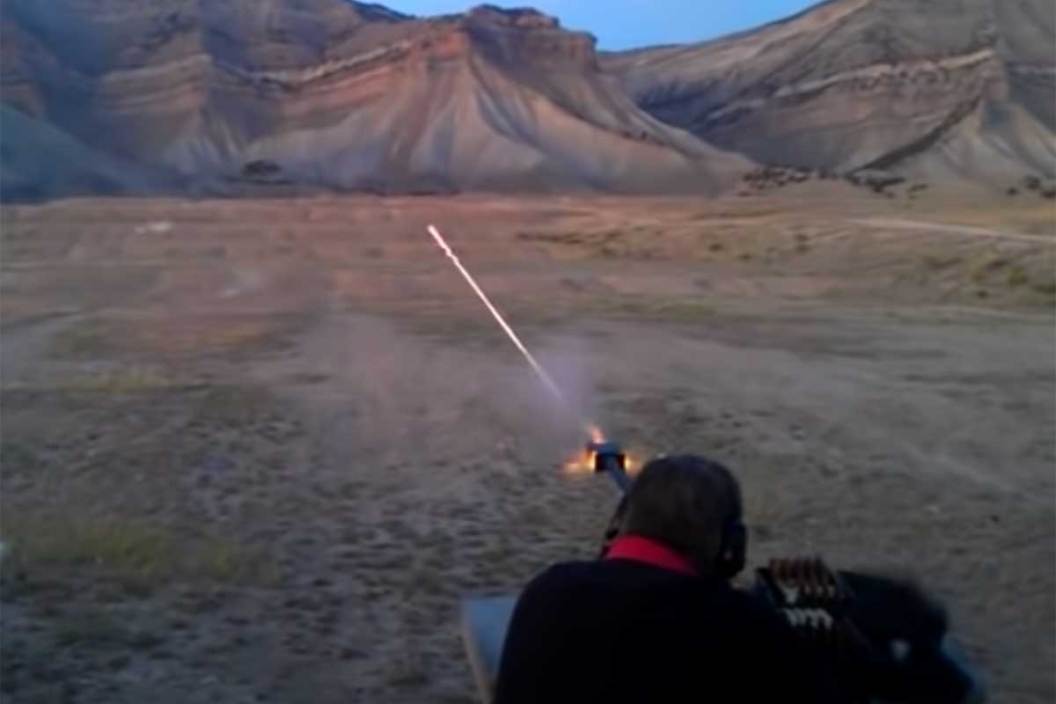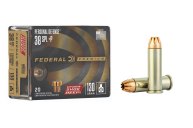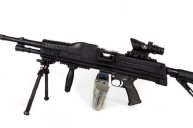Tracer ammo is an important tool on the battlefield, and a lot of fun at the range (in proper and safe conditions, of course).
What is tracer ammunition? It's a fairly simple concept.
Tracer bullets are projectiles with a small pyrotechnic charge affixed to their base. When a round is fired, that pyrotechnic composition is ignited by the burning propellant in the cartridge case, and in turn, burns very brightly, either simply in white light or colored light. Typically tracer rounds will be indicated by a colored tip on the bullet.
The pyrotechnic composition is typically magnesium-based. The old-school orange-tipped .30-06 military tracer cartridge used a tracer compound called R 321, which consisted of polyvinyl chloride, magnesium powder, and strontium nitrate. The M62 orange-tipped 7.62 NATO tracer rounds used composition R 284, which was nearly identical.
Tracer compositions can also emit primarily in infrared for use with night vision devices.
What is the purpose of tracer ammunition?
Why would anyone want this? Again, it's a really simple concept. When machine guns hit the battlefield, a problem became apparent. In the dark or in heavy brush, machine gunners couldn't see their bullet hits and adjust their fire. Tracer rounds allow the gunners to see the trajectory of their rounds with the naked eye, and adjust accordingly.
While tracers are visible in daylight, they are especially visible in low light or at night. Additionally, since everyone can see tracers and the direction in which they are being fired, tracer fire can be used to mark targets or fields of fire for other gunners or even helicopters. Tracers can also be used in small arms.
Unfortunately, the trade-off is that tracer fire makes it fairy easy for the enemy to spot machine gun positions.
When using tracer ammo in a machine gun, not every round is a tracer. Typically, every fifth round in a machine gun ammo belt is a tracer, referred to as a four-to-one tracer. Sometimes a squad leader might load tracer rounds in their magazine so they can indicate where their team should fire.
Two or three tracer rounds at the end of a magazine can signal to the user that their mag is almost empty. WWII fighter aircraft with fixed machine guns and cannons would sometimes have a few tracer rounds near the end of their ammo belts for the same purpose, but more often, they were loaded four-to-one. Many WWII aircraft used tracers, especially in conjunction with the Browning M2 .50 Caliber machine guns on heavy bombers, like the B-24, which were used as defensive guns against fighters and other aircraft.
Types of Tracer Ammo
Today, there are three main types of tracer ammunition: bright tracers, subdued tracers, and dim tracers. The standard bright tracers are too bright and blow out night-vision optics at night. They also begin burning almost as soon as they leave the barrel, so they are very good at giving away a gunner's position. Subdued tracers still burn at full brightness, but they don't start burning until up to 100 yards out, making it much more difficult for the enemy to ID the source.
Dim tracers are hardly visible to the naked eye, but they are plenty bright enough to be viewed through night-vision equipment. The M276 round is a violent-tipped 7.62 NATO dim tracer with a tracer compound consisting of barium peroxide, strontium peroxide, calcium resinate, and magnesium carbonate.
While they are mostly restricted to military use, some tracers are legally attainable by civilians and will work with any 5.56 or 7.62 firearm, and they are a lot of fun to shoot in low light at a gun range.
Tracer Ammo Considerations
Now, technically tracer rounds are incendiary rounds, as they are burning as they fly through the air. As such, they are flammable and can be adept at setting dry brush on fire down range.
Most shooting ranges restrict or ban the use of tracer ammo for this reason, or don't allow it if conditions are too dry. Make sure you inquire about this before showing up to any old range with the intentions of firing tracers.
Tracer ammunition can be found pretty much wherever ammunition is sold, especially online. Typically they are fairly expensive and sold in small quantities. However, they are available in pretty much any caliber you can imagine, from .22LR, 9mm, and .45 ACP to .223 and .308.
While it may not seem like it, there are a few uses for tracer ammo in the hunting realm. Hog hunters like dim tracers for taking out the feral beasts at night with night vision or thermal optics. Rimfire tracer ammo is also useful for prairie dog control and even squirrel hunting, if local laws permit the use of such ammo for hunting.
NEXT: THE WORLD'S FIRST ANTI-TANK GUN, THE TANKGEWEHR M1918 PACKS A PUNCH
WATCH





